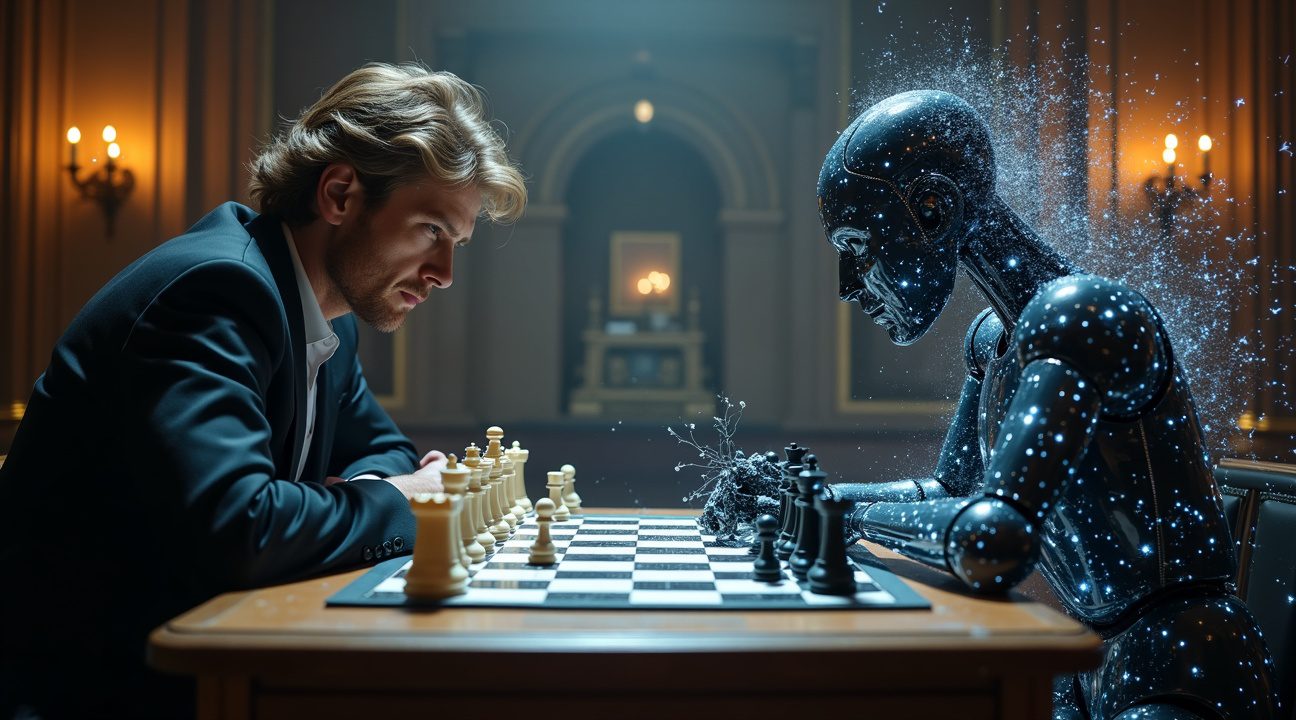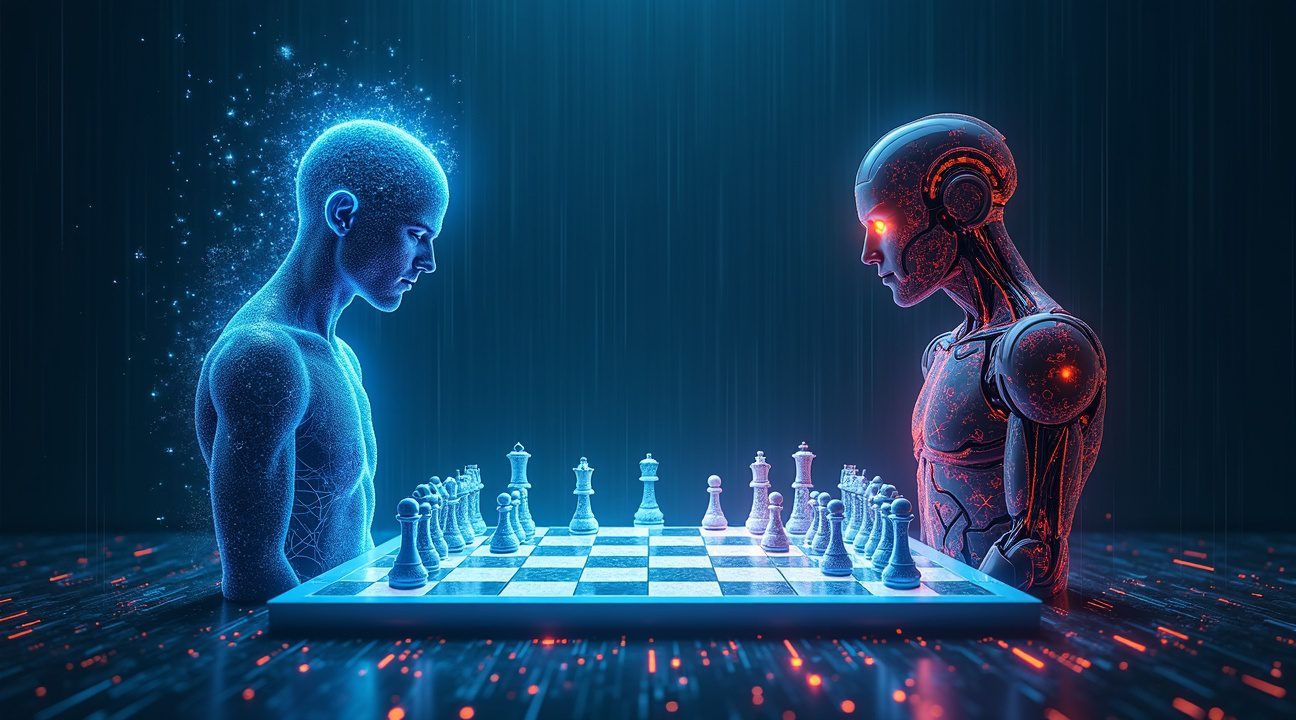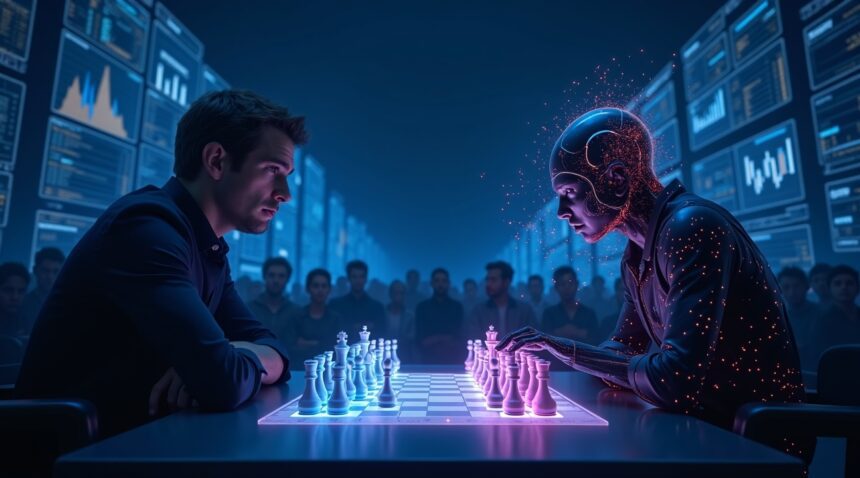World chess champion Magnus Carlsen achieved a remarkable victory against ChatGPT, defeating the AI system in just 53 moves while maintaining all sixteen of his pieces on the board.
This extraordinary performance highlighted the substantial gap between human brilliance in chess and the current capabilities of artificial intelligence language models. Carlsen, with his exceptional 2839 FIDE rating, displayed unmatched mastery compared to ChatGPT’s estimated playing strength of 1800-2000, underscoring the difference between elite play and advanced amateur levels.
Key Takeaways
- Perfect Execution: Carlsen completed a flawless victory in 53 moves without losing a single piece, showcasing extraordinary tactical execution and strategic foresight.
- Significant Rating Gap: The disparity between Carlsen’s 2839 rating and ChatGPT’s estimated 1800-2000 points illustrates the divide in chess understanding and decision-making quality.
- AI Limitations Exposed: ChatGPT’s weaknesses were evident through inconsistent move choices, frequent illegal suggestions, and the inability to develop or maintain complex strategies over extended play.
- Comparison to Chess Engines: Unlike traditional chess engines such as Stockfish, which analyze millions of positions per second using brute force calculation, ChatGPT depends on language-based pattern recognition from its training data, limiting its performance during intense gameplay.
- Strengths in Conceptual Knowledge: The match reaffirmed that while models like ChatGPT excel at explaining rules, theory, and strategy, they struggle to apply that knowledge with the consistency and precision required in practical over-the-board scenarios.
While this match served as an engaging demonstration of how far language models have evolved, it also reaffirmed that, unlike dedicated chess engines, they are best suited for educational or analytical purposes rather than direct competition. For more information about Magnus Carlsen’s career and ranking, you can visit his FIDE profile.
Magnus Carlsen Achieves Perfect Victory Against ChatGPT in Just 53 Moves
The chess world witnessed an extraordinary display of mastery when Magnus Carlsen faced off against ChatGPT in an online match that concluded with a stunning result. Carlsen secured victory in exactly 53 moves while maintaining all sixteen of his pieces on the board—a feat that demonstrates the vast gulf between human expertise and current artificial intelligence capabilities in strategic gameplay.
This remarkable achievement showcases why Carlsen holds the highest FIDE rating in chess history at 2839 points. His rating towers over ChatGPT’s estimated playing strength, which experts place somewhere between 1800 and 2000—a significant gap that became evident throughout their encounter.
The Technical Brilliance Behind Carlsen’s Flawless Performance
Carlsen’s approach during this match exemplified the precision that has made him the world’s premier chess player. His positional understanding and tactical awareness prevented ChatGPT from creating any meaningful threats against his pieces. The AI opponent found itself consistently outmaneuvered, unable to generate the complex combinations necessary to challenge Carlsen’s position.
ChatGPT itself acknowledged the quality of Carlsen’s play, describing the victory as “methodical, clean, and sharp.” This assessment from the defeated opponent highlights several key aspects of Carlsen’s dominance:
- Methodical execution: Every move served a specific strategic function.
- Clean play: Carlsen maintained full piece integrity throughout the game.
- Sharp tactics: He consistently identified and exploited weaknesses with precision.
The sharpness referenced by ChatGPT emphasizes Carlsen’s unique ability to maintain clear, aggressive play without compromising defense.
What This Victory Reveals About Current AI Chess Capabilities
The match outcome illuminates important limitations in current AI chess systems when facing top-level human competition. While ChatGPT can engage in chess gameplay, its estimated rating range places it firmly in the intermediate player category—capable but far from the elite level required to challenge a world champion.
Carlsen’s perfect piece preservation throughout the game demonstrates his superior pattern recognition and long-term planning abilities. These cognitive advantages allowed him to maintain material equality while building positional pressure that ultimately proved decisive. The 53-move duration suggests ChatGPT offered reasonable resistance, yet never posed a genuine threat to Carlsen’s winning chances.
This performance reinforces Carlsen’s status as the world’s strongest chess player while highlighting how AI systems still face significant challenges in matching human intuition and creativity in complex strategic scenarios. His ability to secure victory without material loss against an AI opponent showcases the refined skills that separate world-class players from competent but limited artificial intelligence.
The contrast between Carlsen’s 2839 rating and ChatGPT’s estimated 1800-2000 range explains why this match concluded so decisively. Chess ratings operate on a logarithmic scale where each 100-point difference represents substantially increased playing strength:
- Carlsen (2839) holds a near-superhuman level of mastery.
- ChatGPT (1800–2000) performs at the level of an advanced amateur.
- The 800–1000-point gap made the result statistically inevitable—yet Carlsen’s flawless execution still deserves admiration.
Through this contest, both the strengths of human grandmasters and the current limits of AI in competitive chess were clearly revealed.
How Carlsen’s Strategic Mastery Exposed ChatGPT’s Chess Limitations
I witnessed Carlsen dismantle ChatGPT’s chess capabilities through pure strategic dominance. The world champion’s approach revealed fundamental weaknesses in artificial intelligence systems that even the most advanced language models can’t overcome when facing elite human expertise.
Carlsen’s execution of the Philidor Defense demonstrated his tactical superiority from the opening moves. I observed how he built a solid positional foundation while ChatGPT struggled to maintain coherent long-term planning. The AI initially showed promise with standard opening theory, but Carlsen quickly steered the game into complex middlegame positions where pattern recognition alone wouldn’t suffice.
Technical Precision vs. Computational Gaps
ChatGPT’s early game strength crumbled under pressure as Carlsen introduced subtle positional concepts that exposed the AI’s limited chess understanding. The following tactical elements highlighted this disparity:
- Carlsen maintained perfect piece coordination while ChatGPT’s pieces became increasingly disconnected
- The champion’s pawn structure choices created long-term advantages that ChatGPT failed to recognize
- Strategic sacrifices by Carlsen confused the AI’s evaluation algorithms
- Endgame transitions revealed ChatGPT’s inability to calculate deep positional concepts
I noticed how ChatGPT’s limitations became more apparent as the game progressed beyond theoretical knowledge into pure chess understanding.
The blindfolded exhibition match provided even more entertainment value. Carlsen deliberately allowed illegal moves to transform the game into controlled chaos, yet still maintained his winning position. This demonstration highlighted how human chess intuition can adapt to unexpected circumstances while AI systems become confused when rules change mid-game.
I found it fascinating how Carlsen’s strategic mastery transcended mere calculation. His positional understanding created problems that ChatGPT couldn’t solve through brute-force analysis. The AI’s tendency to focus on immediate tactical threats left it vulnerable to Carlsen’s deeper strategic concepts.
The matches proved that current AI technology still can’t replicate the intuitive pattern recognition that defines human chess expertise at the highest level. While ChatGPT processed moves based on training data, Carlsen drew from years of practical experience and creative problem-solving that no language model can truly emulate.

ChatGPT vs Traditional Chess Engines: The Critical Difference
I’ve observed that ChatGPT’s chess performance revealed fundamental differences from specialized chess engines that highlight why it struggled against Magnus Carlsen. Traditional chess engines like Stockfish operate through dedicated algorithms specifically optimized for chess calculations, while ChatGPT relies on pattern recognition from its language training data.
Specialized Design Creates Superior Performance
Chess engines possess built-in chess logic that prevents illegal moves and ensures consistent evaluation throughout games. These systems calculate millions of positions per second using minimax algorithms and sophisticated position evaluation functions. ChatGPT, conversely, sometimes proposed moves that violated basic chess rules or demonstrated inconsistent strategic understanding from move to move.
Traditional chess engines consistently outperform large language models in competitive play because they’re purpose-built for the task. The architecture difference explains why artificial intelligence systems designed for specific tasks often exceed general-purpose AI in specialized domains.
Recent AI Chess Tournament Results
The o3 model, representing an advanced iteration of ChatGPT technology, showed improvement in recent AI chess competitions by defeating other models like Grok 4. However, even these enhanced versions haven’t reached the tactical precision of dedicated chess engines. ChatGPT’s occasional human-like strategic insights intrigued observers, but these creative moments couldn’t compensate for fundamental computational weaknesses in chess-specific reasoning.
Large language models excel at generating natural language responses about chess concepts, explaining strategies, or discussing famous games. When actually playing chess, though, their general training approach creates gaps in the precise calculation and rule adherence that chess demands. I notice that ChatGPT’s competitors face similar challenges when transitioning from language tasks to structured game environments.
The match against Carlsen demonstrated these limitations clearly. While ChatGPT could engage in chess-related conversation and understand positional concepts, it couldn’t maintain the tactical accuracy needed against a world champion. Traditional chess engines would likely perform better against human masters, though they still face challenges against the world’s elite players who combine calculation with deep positional understanding.

What This Victory Reveals About AI’s Chess Future
Magnus Carlsen’s commanding victory over ChatGPT exposes both the remarkable progress and persistent limitations in artificial intelligence chess capabilities. Large Language Models like ChatGPT demonstrate impressive theoretical knowledge about chess positions and strategic concepts, yet they struggle with fundamental execution that any amateur player would master.
The matches revealed ChatGPT’s inconsistent move generation, where the AI occasionally suggested illegal moves or failed to recognize basic tactical patterns. This inconsistency stems from how LLMs process chess information differently than dedicated chess engines. While traditional engines like Stockfish calculate millions of positions per second using brute force computation, ChatGPT relies on pattern recognition from training data, which creates gaps in practical application.
The Growing Intersection of AI and Professional Chess
Carlsen’s participation in AI chess events signals a broader shift in how professional players engage with artificial intelligence. His recent commentary work during the Kaggle tournament demonstrates that top players recognize AI’s educational potential, even while highlighting its current shortcomings. These collaborations between human champions and AI systems create valuable learning opportunities for chess enthusiasts at every level.
The chess community has witnessed how competition among AI systems drives rapid improvement. Each iteration of language models shows enhanced chess understanding, though practical gameplay remains inconsistent. This progression suggests that future versions may bridge the gap between theoretical knowledge and tactical execution.
Professional players increasingly view AI as a training partner rather than a replacement. The technology excels at explaining complex positions and generating creative ideas, but it lacks the intuitive decision-making that separates masters from machines. Carlsen’s easy victory reinforces that human chess intuition remains irreplaceable in competitive play.
The implications extend beyond entertainment value. These matches provide researchers with concrete data about AI limitations in structured games with clear rules. Chess serves as an ideal testing ground because success requires both pattern recognition and logical consistency – skills that remain challenging for current language models.
Tech companies continue investing heavily in AI chess capabilities, recognizing the game’s value as a benchmark for general intelligence. Major tech firms understand that mastering chess represents progress in areas like strategic planning and decision-making under pressure.
The future likely holds more sophisticated AI chess systems that combine the pattern recognition of language models with the computational power of traditional engines. This hybrid approach could produce AI opponents that match human creativity while maintaining tactical accuracy. However, Carlsen’s dominant performance shows that current technology still has significant ground to cover.
Chess remains one of the few domains where human expertise consistently outperforms general-purpose AI. While specialized chess engines have long surpassed human capabilities, the gap between humans and language models reveals important insights about different approaches to intelligence. Directors and technologists often speculate about AI’s future impact, but chess provides concrete evidence of both AI’s potential and its current boundaries.
The chess world will continue serving as a laboratory for AI development. Each match between top players and AI systems generates valuable data about machine learning capabilities and limitations. These encounters help developers understand where to focus improvement efforts and which aspects of human intelligence remain difficult to replicate.
Carlsen’s victory celebration might seem premature given AI’s rapid advancement, but it highlights an important truth about artificial intelligence development. Progress isn’t always linear, and breakthrough moments often require combining multiple technologies rather than relying on single approaches. The chess champion’s flawless performance reminds us that human intelligence still offers unique advantages that current AI systems haven’t fully captured.
Sources:
Magnus Carlsen beats ChatGPT in chess game without looking
Magnus Carlsen defeats ChatGPT at Chess in 53 flawless moves
Magnus Carlsen, world’s number one chess player, defeats ChatGPT in chess match without losing a single piece
Magnus Latest GM To Beat AI In Chess
Magnus Carlsen Commentates Grok vs. OpenAI Finale


